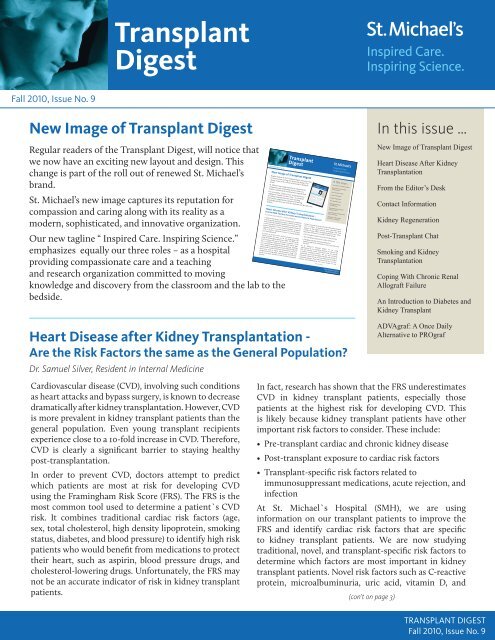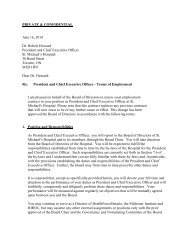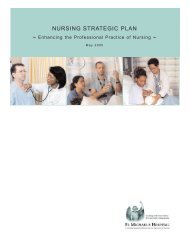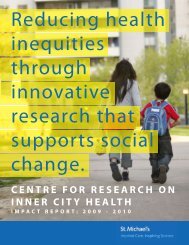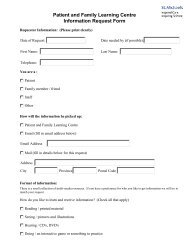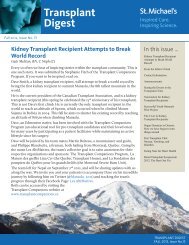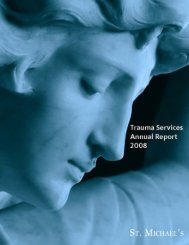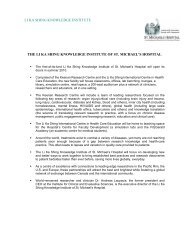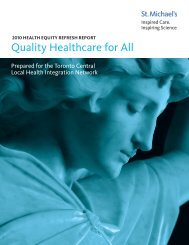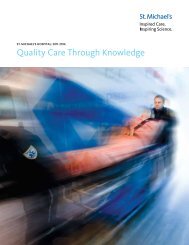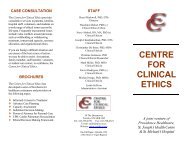Transplant Digest - Fall 2010, Issue No. 9 - St. Michael's Hospital
Transplant Digest - Fall 2010, Issue No. 9 - St. Michael's Hospital
Transplant Digest - Fall 2010, Issue No. 9 - St. Michael's Hospital
You also want an ePaper? Increase the reach of your titles
YUMPU automatically turns print PDFs into web optimized ePapers that Google loves.
edside.<br />
<strong>Fall</strong> , I sue <strong>No</strong>.<br />
•<br />
infection<br />
(con’t on page 3)<br />
<strong>Transplant</strong><br />
<strong>Digest</strong><br />
Fa l , <strong>Issue</strong> <strong>No</strong>.<br />
Regula readers the <strong>Transplant</strong> <strong>Digest</strong>, wi l notice that<br />
we now have an exciting new layout an design. This<br />
change is part of the ro l out of renewed <strong>St</strong>. Michael’s<br />
brand.<br />
<strong>St</strong>. Michael’s new image captures its reputation for<br />
compassion caring along with its reality as a<br />
modern, sophisticated, innovative organization.<br />
Our new tagline “ Inspired Care. Inspiring Science.”<br />
emphasizes equa ly our three roles – as hospital<br />
providing compa sionate care and a teaching<br />
and research organization mitted to moving<br />
knowledge an discovery from the cla sr om and the lab to bedside.<br />
Dr. Samuel Silver, Resident in Internal Medicine<br />
New Image of <strong>Transplant</strong> <strong>Digest</strong><br />
Heart Disease after Kidney <strong>Transplant</strong>ation -<br />
Are the Risk Factors the same as the General Population<br />
Cardiovascular disease (CVD), involving such conditions In fact, researc ha shown tha the FRS underestimates<br />
as heart a tacks and bypa surgery, is known to decrease CVD kidney transplant patients, especia ly those<br />
dramatica ly after kidney transplantation. However, CVD patients a the highest risk for developing CVD. This<br />
is more prevalent in kidney patients than the is likely because kidney transplant patients have other<br />
general population. Even young transplant recipients important risk factors to consider. These include:<br />
experience close to 10-fold increase CVD. Therefore,<br />
Pre-transplant cardiac and chronic kidney disease<br />
CVD is clearly significant barrier to staying healthy<br />
post-transplantation.<br />
Post-transplant exposure to cardiac risk factors<br />
In order to prevent CVD, doctors a temp to predict •<br />
which patients are most for developing CVD i munosu sant medications, acute rejection, and<br />
using the Framingham Risk Score (FRS). The is the infection<br />
most mon tool used determine a patient`s CVD At <strong>St</strong>. Michael`s <strong>Hospital</strong> (SMH), we are using<br />
risk. It combines traditional cardiac factors (age, information on our transplant patients improve the<br />
sex, total cholesterol, high density lipoprotein, smoking<br />
identify cardiac risk factors that are specific<br />
status, diabetes, and bl od sure) to identify high risk to kidney transplant patients. We are now studying<br />
patients who would benefit fro medications protect traditional, novel, and transplant-specific risk factors their heart, such as aspirin, bl od pressure drugs, and determine which factors are most important in kidney<br />
cholesterol-lowering drugs. Unfortunately, the FRS may transplant patients. <strong>No</strong>vel risk factors such as C-reactive<br />
not be an a curate indicator of risk kidney protein, microalbuminuria, uric acid, vitamin D, and<br />
patients.<br />
TRANSPLANT DIGEST<br />
Fa l <strong>2010</strong><br />
(con’t on page 3)<br />
New Image of <strong>Transplant</strong> <strong>Digest</strong><br />
Heart Disease After Kidney<br />
<strong>Transplant</strong>ation<br />
From the Editor’s Desk<br />
Contact Information<br />
Regeneration<br />
Post-<strong>Transplant</strong> Chat<br />
Smoking and Kidney<br />
<strong>Transplant</strong>ation<br />
Coping With Chronic Renal<br />
A lograft Failure<br />
An Introduction to Diabetes and<br />
Kidney <strong>Transplant</strong><br />
ADVAgraf: Once Daily<br />
Alternative to PROgraf<br />
In this i sue ...<br />
TRANSPLANT DIGEST<br />
Fa l <strong>2010</strong><br />
Coping With Chronic Renal<br />
A lograft Failure<br />
An Introduction to Diabetes and<br />
Kidney <strong>Transplant</strong><br />
ADV A graf: A Once Daily<br />
Alternative to PROgraf<br />
In this i sue ..<br />
<strong>Transplant</strong><br />
<strong>Digest</strong><br />
<strong>Fall</strong> <strong>2010</strong>, <strong>Issue</strong> <strong>No</strong>. 9<br />
New Image of <strong>Transplant</strong> <strong>Digest</strong><br />
Regular readers of the <strong>Transplant</strong> <strong>Digest</strong>, will notice that<br />
we now have an exciting new layout and design. This<br />
change is part of the roll out of renewed <strong>St</strong>. Michael’s<br />
brand.<br />
<strong>St</strong>. Michael’s new image captures its reputation for<br />
compassion and caring along with its reality as a<br />
modern, sophisticated, and innovative organization.<br />
<strong>Fall</strong> , <strong>Issue</strong> <strong>No</strong>.<br />
Our new tagline “ Inspired Care. Inspiring Science.”<br />
emphasizes equally our three roles – as a hospital<br />
providing compassionate care and a teaching<br />
and research organization committed to moving<br />
knowledge and discovery from the classroom and the lab to the<br />
bedside.<br />
<strong>Transplant</strong><br />
<strong>Digest</strong><br />
New Image of <strong>Transplant</strong> <strong>Digest</strong><br />
Regula readers of the <strong>Transplant</strong> <strong>Digest</strong>, will notice that<br />
we now have an exciting new layout and design. This<br />
change is part of the roll out of renewed <strong>St</strong>. Michael’s<br />
brand.<br />
<strong>St</strong>. Michael’s new image captures its reputation for<br />
compassion and caring along with its reality as a<br />
modern, sophisticated, and innovative organization.<br />
Our new tagline “ Inspired Care. Inspiring Science.”<br />
emphasizes equally our three roles – as a hospital<br />
providing compassionate care and a teaching<br />
and research organization committed to moving<br />
knowledge and discovery from the classroom and the lab to the<br />
bedside.<br />
Heart Disease after Kidney <strong>Transplant</strong>ation -<br />
Are the Risk Factors the same as the General Population<br />
Dr. Samuel Silver, Resident in Internal Medicine<br />
Cardiovascular disease (CVD), involving such conditions<br />
as heart attacks and bypass surgery, is known to decrease<br />
dramatically after kidney transplantation. However, CVD<br />
is more prevalent in kidney transplant patients than the<br />
general population. Even young transplant recipients<br />
experience close to a 10-fold increase in CVD. Therefore,<br />
CVD is clearly a significant barrier to staying healthy<br />
post-transplantation.<br />
In order to prevent CVD, doctors attempt to predict<br />
which patients are most at risk for developing CVD<br />
using the Framingham Risk Score (FRS). The FRS is the<br />
most common tool used to determine a patient`s CVD<br />
risk. It combines traditional cardiac risk factors (age,<br />
sex, total cholesterol, high density lipoprotein, smoking<br />
status, diabetes, and blood pressure) to identify high risk<br />
patients who would benefit from medications to protect<br />
their heart, such as aspirin, blood pressure drugs, and<br />
cholesterol-lowering drugs. Unfortunately, the FRS may<br />
not be an accurate indicator of risk in kidney transplant<br />
patients.<br />
<strong>Transplant</strong><br />
<strong>Digest</strong><br />
New Image of <strong>Transplant</strong> <strong>Digest</strong><br />
Regula readers of the <strong>Transplant</strong> <strong>Digest</strong>, will notice that<br />
we now have an exciting new layout an design. This<br />
change is part of the ro l out of renewed <strong>St</strong>. Michael’s<br />
brand.<br />
<strong>St</strong>. Michael’s new image captures its reputation for<br />
compassion and caring along with its reality as a<br />
modern, sophisticated, and innovative organization.<br />
Our new tagline “ Inspired Care. Inspiring Science.”<br />
emphasizes equa ly our three roles – as a hospital<br />
providing compa sionate care and a teaching<br />
and research organization commi ted to moving<br />
knowledge an discovery from the cla sroom and the lab to the<br />
Heart Disease after Kidney <strong>Transplant</strong>ation -<br />
Are the Risk Factors the same as the General Population<br />
Dr. Samuel Silver, Resident in Internal Medicine<br />
Cardiovascular disease (CVD), involving such conditions<br />
as heart a tacks and bypa surgery, is known to decrease<br />
dramatically after kidney transplantation. However, CVD<br />
is more prevalent in kidney transplant patients than the<br />
general population. Even young recipients<br />
experience close to 10-fold increase CVD. Therefore,<br />
CVD is clearly a significant ba rier to staying healthy<br />
post-transplantation.<br />
In order to prevent CVD, doctors a temp to predict<br />
which patients are most at risk for developing CVD<br />
using the Framingham Risk Score (FRS). The FRS is the<br />
most co mon t ol used to determine a patient`s CVD<br />
risk. It combines traditional cardiac risk factors (age,<br />
sex, total cholesterol, high density lipoprotein, smoking<br />
status, diabetes, and pressure) to identify high risk<br />
patients who would benefit fro medications to protect<br />
their heart, such as aspirin, blood pre sure drugs, and<br />
cholesterol-lowering drugs. Unfortunately, the FRS may<br />
not be an a curate indicator of risk in kidney transplant<br />
patients.<br />
In fact, researc ha shown that the FRS underestimates<br />
CVD in kidney transplant patients, especia ly those<br />
patients a the highest risk for developing CVD. This<br />
is likely because kidney transplant patients have other<br />
important risk factors consider. These include:<br />
Pre-transplant cardiac and chronic kidney disease<br />
• Post-transplant exposure to cardiac risk factors<br />
i munosuppre sant medications, acute rejection, and<br />
At <strong>St</strong>. Michael`s <strong>Hospital</strong> (SMH), we are using<br />
information on our transplant patients improve the<br />
FRS and identify cardiac risk factors that are specific<br />
to kidney transplant patients. We are now studying<br />
traditional, novel, and transplant-specific risk factors determine which factors are most important in kidney<br />
transplant patients. <strong>No</strong>vel risk factors such as C-reactive<br />
protein, microalbuminuria, uric acid, vitamin D, and<br />
In this issue ...<br />
New Image of <strong>Transplant</strong> <strong>Digest</strong><br />
Heart Disease After Kidney<br />
<strong>Transplant</strong>ation<br />
From the Editor’s Desk<br />
Contact Information<br />
Kidney Regeneration<br />
Post-<strong>Transplant</strong> Chat<br />
Smoking and Kidney<br />
<strong>Transplant</strong>ation<br />
Coping With Chronic Renal<br />
Allograft Failure<br />
An Introduction to Diabetes and<br />
Kidney <strong>Transplant</strong><br />
ADVAgraf: A Once Daily<br />
Alternative to PROgraf<br />
In fact, research has shown tha the FRS underestimates<br />
CVD in kidney transplant patients, especially those<br />
patients at the highest risk for developing CVD. This<br />
is likely because kidney transplant patients have other<br />
important risk factors to consider. These include:<br />
• Pre-transplant cardiac and chronic kidney disease<br />
• Post-transplant exposure to cardiac risk factors<br />
•<br />
immunosuppressant medications, acute rejection, and<br />
infection<br />
At <strong>St</strong>. Michael`s <strong>Hospital</strong> (SMH), we are using<br />
information on our transplant patients to improve the<br />
FRS and identify cardiac risk factors that are specific<br />
to kidney transplant patients. We are now studying<br />
traditional, novel, and transplant-specific risk factors to<br />
determine which factors are most important in kidney<br />
transplant patients. <strong>No</strong>vel risk factor such as C- reactive<br />
protein, microalbuminuria, uric acid, vitamin D, and<br />
(con’t on page 3)<br />
New Image of <strong>Transplant</strong> <strong>Digest</strong><br />
Heart Disease After Kidney<br />
<strong>Transplant</strong>ation<br />
From the Editor’s Desk<br />
Contact Information<br />
Kidney Regeneration<br />
Post-<strong>Transplant</strong> Chat<br />
Smoking and Kidney<br />
<strong>Transplant</strong>ation<br />
TRANSPLANT DIGEST<br />
Fa l <strong>2010</strong>, <strong>Issue</strong> <strong>No</strong>. 9<br />
In this issue ...<br />
New Image of <strong>Transplant</strong> <strong>Digest</strong><br />
Heart Disease After Kidney<br />
<strong>Transplant</strong>ation<br />
From the Editor’s Desk<br />
Contact Information<br />
Kidney Regeneration<br />
Post-<strong>Transplant</strong> Chat<br />
Smoking and Kidney<br />
<strong>Transplant</strong>ation<br />
Coping With Chronic Renal<br />
Allograft Failure<br />
An Introduction to Diabetes and<br />
Kidney <strong>Transplant</strong><br />
Heart Disease after Kidney <strong>Transplant</strong>ation -<br />
Are the Risk Factors the same as the General Population<br />
Dr. Samuel Silver, Resident in Internal Medicine<br />
Cardiovascular disease (CVD), involving such conditions<br />
as heart attacks and bypass surgery, is known to decrease<br />
dramatically after kidney transplantation. However, CVD<br />
is more prevalent in kidney transplant patients than the<br />
general population. Even young transplant recipients<br />
experience close to a 10-fold increase in CVD. Therefore,<br />
CVD is clearly a significant barrier to staying healthy<br />
post-transplantation.<br />
In order to prevent CVD, doctors attempt to predict<br />
which patients are most at risk for developing CVD<br />
using the Framingham Risk Score (FRS). The FRS is the<br />
most common tool used to determine a patient`s CVD<br />
risk. It combines traditional cardiac risk factors (age,<br />
sex, total cholesterol, high density lipoprotein, smoking<br />
status, diabetes, and blood pressure) to identify high risk<br />
patients who would benefit from medications to protect<br />
their heart, such as aspirin, blood pressure drugs, and<br />
cholesterol-lowering drugs. Unfortunately, the FRS may<br />
not be an accurate indicator of risk in kidney transplant<br />
patients.<br />
Advagraf: A Once Daily<br />
Alternative to Prograf<br />
In fact, research has shown that the FRS underestimates<br />
CVD in kidney transplant patients, especially those<br />
patients at the highest risk for developing CVD. This<br />
is likely because kidney transplant patients have other<br />
important risk factors to consider. These include:<br />
• Pre-transplant cardiac and chronic kidney disease<br />
• Post-transplant exposure to cardiac risk factors<br />
• <strong>Transplant</strong>-specific risk factors related to<br />
immunosuppressant medications, acute rejection, and<br />
infection<br />
At <strong>St</strong>. Michael`s <strong>Hospital</strong> (SMH), we are using<br />
information on our transplant patients to improve the<br />
FRS and identify cardiac risk factors that are specific<br />
to kidney transplant patients. We are now studying<br />
traditional, novel, and transplant-specific risk factors to<br />
determine which factors are most important in kidney<br />
transplant patients. <strong>No</strong>vel risk factors such as C-reactive<br />
protein, microalbuminuria, uric acid, vitamin D, and<br />
(con’t on page 3)<br />
TRANSPLANT DIGEST<br />
<strong>Fall</strong> <strong>2010</strong>, <strong>Issue</strong> <strong>No</strong>. 9
From the Editor’s Desk<br />
An important goal of <strong>Transplant</strong><br />
<strong>Digest</strong> is to impart kidney<br />
transplant-related information<br />
to both patients and health<br />
care providers in a readable,<br />
understandable form that will not<br />
become outdated anytime soon.<br />
To this end, we have strived to<br />
cover the spectrum of important<br />
problems that transplant<br />
recipients may come across over<br />
a number of <strong>Digest</strong> issues, meant<br />
therefore to be kept together in<br />
one place. In keeping with this<br />
quest for originality, this edition<br />
carries new articles on a broad<br />
variety of topics, a few of which<br />
will interest everybody, and all of<br />
which will interest many.<br />
Our medical trainees, the<br />
doctors of tomorrow, obliged our<br />
request to provide you with their<br />
insights in to the risks for heart<br />
disease after transplantation,<br />
particularly smoking. For the<br />
smokers among our patients,<br />
may be these articles will finally<br />
convince you to quit. We also get<br />
many questions about growing<br />
new kidneys in a test tube as<br />
an alternative to transplant,<br />
for which we have provided an<br />
article written just for you by<br />
one of our senior trainees. We<br />
have a detailed explanation about<br />
tacrolimus formulations from our<br />
pharmacist, and an article about<br />
coping with transplant failure<br />
from social work. References<br />
are provided for many articles<br />
for those desiring further<br />
information. Our nurses’ everpopular<br />
post-transplant chat<br />
covers the all-pervading problem<br />
of anemia. All the authors and<br />
staff will find your comments and<br />
suggestions about <strong>Transplant</strong><br />
<strong>Digest</strong> to be most welcome.<br />
Dr. Ramesh Prasad,<br />
Editor<br />
Contact Information<br />
Dr. Ramesh Prasad – Editor<br />
Meriam Jayoma-Austria, RN, CNeph(C) – Newsletter Coordinator<br />
<strong>St</strong>. Michael’s <strong>Hospital</strong><br />
Renal <strong>Transplant</strong> Program<br />
(across the hospital)<br />
61 Queen <strong>St</strong>reet 9th Floor<br />
Toronto, Ontario, M5C 2T2<br />
Phone: (416) 867-3665<br />
Please send your comments or suggestions<br />
of topics for future publication to:<br />
jayomam@smh.ca<br />
Disclaimer <strong>No</strong>te:<br />
Views presented in this newsletter are<br />
those of the writers and do not necessarily<br />
reflect those of <strong>St</strong>. Michael’s <strong>Hospital</strong> or the<br />
University of Toronto. Subject matter should<br />
not be construed as specific medical advice<br />
and may not be relevant to individual patient<br />
circumstances. For all questions related to<br />
your own health please contact your health<br />
care provider.<br />
Thank You Josie! All the best!<br />
Jozenine Mislang covered Meriam’s one year maternity leave.<br />
2
(con’t from page 1)<br />
parathyroid hormone are of particular significance, as<br />
they have gathered increased attention in the general<br />
population, but have not been studied extensively in<br />
kidney transplant patients. By routinely measuring<br />
these values in kidney transplant patients at SMH,<br />
we are in an excellent position to determine<br />
if novel risk factors can help improve our<br />
ability to predict CVD.<br />
Thus far, we have found that the traditional<br />
risk factors, especially diabetes and<br />
smoking, which partly make up the FRS<br />
remain important in kidney transplant<br />
patients. Other important cardiac risk<br />
factors include:<br />
• Pre-transplant CVD<br />
• South Asian ethnicity<br />
• Acute rejection<br />
• Delayed graft function<br />
• Estimated glomerular filtration rate (eGFR)<br />
We are currently trying to determine if any of<br />
the above risk factors can improve<br />
the FRS. Our hope is that one day<br />
we might have a tool for kidney<br />
transplant patients to accurately<br />
predict which patients are at low<br />
risk, moderate risk, and high risk of<br />
developing CVD.<br />
We would like to thank all kidney<br />
transplant recipients who participated in<br />
research at SMH in order to help current and<br />
future patients.<br />
Kidney Regeneration: A New Approach to Chronic Kidney Disease<br />
Darren Yuen, MD FRCPC<br />
Kidney regeneration has been a goal<br />
nephrologists have been striving for<br />
over many years. Recent advances in<br />
bioengineering techniques and our<br />
understanding of stem cells has brought<br />
this goal closer to reality.<br />
Bioengineering a scaffold for a new<br />
organ<br />
One of the critical challenges for<br />
regeneration of any organ has been how<br />
to organize the many different types<br />
of cells that make up an organ into a<br />
functioning system. Organs such as the<br />
kidney are complex networks of various<br />
cell types that interact with one another<br />
in very specific ways. While researchers<br />
have for years been able to grow different<br />
kidney cells in culture dishes, they have<br />
had difficulty organizing these cells into<br />
functioning kidneys. Recently, however,<br />
researchers in the United <strong>St</strong>ates have<br />
reported the ability to create “scaffolds”<br />
that help organize cells into proper<br />
locations by removing the cells from<br />
organs supplied by animal or deceased<br />
human donors. Using the heart 1 , liver 2 ,<br />
and lung 3 as examples, these researchers<br />
were able to remove all the original<br />
donor cells, and then seed the leftover<br />
protein skeleton with new cells from<br />
potential recipients. The new organs<br />
were able to perform basic functions.<br />
The importance of this advance is that<br />
it allows doctors to potentially generate<br />
organs that are made up of cells from<br />
the proposed recipient, meaning that<br />
theoretically we will not need to use<br />
immune suppressing drugs to prevent<br />
organ rejection. Interestingly, the first<br />
such tissue-engineered transplantation<br />
occurred in Spain in 2008, where a woman<br />
received a new airway seeded with her<br />
own cells. 4 While this technique has yet<br />
to be applied to the kidney, the above<br />
reports suggest that bioengineering<br />
kidneys is likely something to expect in<br />
the not too distant future.<br />
<strong>St</strong>em cells: a new source of kidney cells<br />
Another major challenge has been<br />
generating sufficient kidney cells to<br />
regenerate kidney tissue (or to form<br />
an entire new kidney). Classically, it<br />
has been thought that most adult cells,<br />
including many in the kidney, are not<br />
able to grow and regenerate new cells<br />
in large numbers. As we understand<br />
biology better, we now recognize that<br />
there are populations of adult stem cells<br />
that possess the ability to regenerate<br />
cells in the kidney and other organs.<br />
Interestingly, the bone marrow has<br />
recently been shown to harbour a<br />
number of cell types that can help<br />
protect and/or regenerate damaged<br />
tissue in the kidney. 5 Work done at<br />
<strong>St</strong>. Michael’s <strong>Hospital</strong>, in fact, has shown<br />
that special cells from the bone marrow<br />
appear to protect the injured kidney<br />
from further damage in experimental<br />
animal models. 6<br />
Together, these exciting advances bring<br />
the hope of protecting and regenerating<br />
kidney tissue closer to reality. Research<br />
into these areas is intensive and ongoing,<br />
and hopefully will bear fruit in the near<br />
future.<br />
1. Ott, H.C., et al. Perfusion-decellularized matrix: using nature’s platform to engineer a bioartificial heart. Nat Med 14, 213-221 (2008).<br />
2. Uygun, B.E., et al. Organ reengineering through development of a transplantable recellularized liver graft using decellularized liver matrix. Nat Med 16, 814-820.<br />
3. Ott, H.C., et al. Regeneration and orthotopic transplantation of a bioartificial lung. Nat Med 16, 927-933.<br />
4. Macchiarini, P., et al. Clinical transplantation of a tissue-engineered airway. Lancet 372, 2023-2030 (2008).<br />
5. Rookmaaker, M.B., et al. Bone-marrow-derived cells contribute to glomerular endothelial repair in experimental glomerulonephritis. Am J Pathol 163, 553-562 (2003).<br />
6. Yuen, D.A., et al. Culture-Modified Bone Marrow Cells Attenuate Cardiac and Renal Injury in a Chronic Kidney Disease Rat Model via a <strong>No</strong>vel Antifibrotic<br />
Mechanism. PLoS ONE 5, e9543.<br />
3
Post-<strong>Transplant</strong> Chat<br />
Thelma Carino, RN, Jennie Huckle, RN and Fernanda Shamy, RN<br />
POST-TRANSPLANT ANEMIA<br />
1. What is anemia Is it bad<br />
Anemia is defined as a hemoglobin level less than 135 g/L in men and 120 g/L in women, on the basis of blood<br />
testing. It is not a single disease, but rather an effect from one or more of a number of processes. Anemia<br />
is bad because it can cause fatigue and breathlessness, and can cause heart damage. Patients with major<br />
illnesses who also have anemia tend to do worse than those without anemia.<br />
2. How can you tell if I have anemia<br />
You may feel very tired or weak, feel your heart beating faster, and feel breathless or cold. Your nails may<br />
lose their natural pinkness, and your mucous membranes (especially the inner part of your lower eyelid) may<br />
look very pale. Most commonly anemia is detected by blood testing, before and after your transplant. Usually<br />
the compete blood count (CBC) in a lavender-top blood tube is checked regularly, but sometimes blood iron<br />
stores, folate and vitamin B12 are also ordered.<br />
3. Why do I have anemia<br />
Almost all patients with chronic kidney disease have anemia, because a hormone called<br />
erythropoietin normally made by the kidneys which tells the bone marrow to make<br />
blood, is no longer produced. If your kidney transplant also does not make enough of<br />
this hormone you may have anemia. Unfortunately some of your anti-rejection drugs<br />
and blood pressure lowering drugs which you need can also contribute. You may be<br />
deficient in essential nutrients like iron, folic acid, and vitamin B12. You could also<br />
have an infection which makes it difficult for your body to use these nutrients properly.<br />
Another important cause is blood loss, such as from heavy menstrual bleeding or<br />
bleeding from your stomach or bowels. Sometimes diseases in other organs like the<br />
liver or thyroid can also cause anemia. Rarely, you may be breaking down blood cells<br />
in your bloodstream as a result of certain diseases or drug reactions. Routine blood<br />
testing, even if frequent, is not usually a cause. Anemia is normal and to be expected in<br />
pregnancy. It is usually hard to find a single explanation for anemia.<br />
4. I used to have anemia on dialysis. Will I still have it after my transplant<br />
Some patients continue to have anemia after their transplant due to one or more of the causes listed above.<br />
More commonly however it corrects on its own if the transplant is working well. This may take a few<br />
months.<br />
5. Will fixing anemia solve all my problems<br />
<strong>No</strong>, unless your symptoms were strictly due to anemia. This is rarely the case. Years of chronic kidney disease<br />
take their toll on the body, so while fixing anemia may solve some aspects of your health situation, it certainly<br />
does not solve everything.<br />
6. Can anemia be improved by diet How about a multivitamin<br />
It certainly helps to eat nutritious food. Your body normally absorbs about 10% of the 10-15 mg of iron present<br />
in a normal diet, and keeps iron balance by losing and absorbing 1 mg per day. Iron rich foods include liver<br />
4
and lean red meats, seafood, various kinds of beans including soybeans, iron-fortified whole grains including<br />
cereals, pasta, and breads, spinach and green leafy vegetables, broccoli, asparagus, and Brussels sprouts. If you<br />
are vegetarian, you do not have to become a meat-eater to get more iron!<br />
Good sources of folic acid include dark green, leafy vegetables, whole wheat bread, beans, peas, nuts and<br />
seeds, sprouts, oranges, liver and other organ meats, and fortified cereals. Vitamin B12 is richly present in<br />
meat and seafood, cheese and eggs. Those who consume no meat or dairy products probably need to take a<br />
supplement. Please check with the transplant clinic before taking any multivitamins.<br />
7. Are there medications which can be used to treat anemia<br />
Sometimes medication becomes necessary. If you are taking an iron supplement, do not stop it without<br />
discussing this at a clinic visit, because your hemoglobin may suddenly “crash”. If you have stomach upset from<br />
an iron tablet, check with our pharmacist who may be able to find another formulation more suited to you. Do<br />
not take iron at the same time as calcium. Do not panic if your stool becomes black with an iron supplement.<br />
Sometimes taking vitamin C along with iron allows it to be absorbed better. Very rarely, intravenous iron<br />
can be given in the hospital. If you have been prescribed folate tablets or vitamin B12 injections, please do not<br />
stop taking them on your own. Rarely, your transplant doctor may decide to change or adjust your transplant<br />
drugs or blood pressure drugs to try to help your body correct the anemia. Finally, you may be asked to take<br />
injections of erythropoietin or darbopoeitin.<br />
8. I have been told to take injections for my anemia. I am nervous about this.<br />
If you took these injections by yourself before the transplant, it will be no different afterwards. If this is your<br />
first time, bring the injection with you back to the transplant clinic as soon as you have filled the prescription<br />
and one of the staff will show you how to inject under the skin. Get a family member involved if needed.<br />
Remember, you can fill your injection only at one pharmacy because it involves special paperwork. Always<br />
keep the syringes stored at the proper temperature so the medication does not get spoiled.<br />
9. Why isn’t my hemoglobin coming back to normal even though I am taking medication for this<br />
Whenever you start an injection or have the dose changed, your hemoglobin should be repeated in 2 weeks.<br />
Often medication adjustment is all that is needed to achieve correction in a few months. Make sure that you<br />
are taking your other medications properly, and are eating a proper diet. If the anemia persists, your doctor<br />
may choose to refer you to another specialist, such as a hematologist or gastroenterologist. Every attempt is<br />
made to avoid blood transfusions. Remember, with injections your target hemoglobin is only 110-120 g/L.<br />
Overcorrecting this into what is the “normal” range for normal people may actually be very harmful.<br />
10. I have been told that my hemoglobin is high.<br />
This is not anemia, is it<br />
This rare but we do see this. It is called erythrocytosis. The<br />
hemoglobin may go up to as high as 200 g/L. <strong>No</strong> one knows<br />
for sure why this happens but it may be related in some way<br />
to the transplant drugs. If this is the case, you may have to<br />
come to the clinic so that some blood can be removed (it is<br />
useless for donation purposes). Some blood pressure drugs<br />
like ACE inhibitors or angiotensin II receptor anatagonists,<br />
which can sometimes contribute to anemia, may actually<br />
be very useful in this situation.<br />
5
Smoking and kidney transplantation: Don’t let your kidney go up in smoke!<br />
Csaba Ambrus, M.D., Ph.D<br />
Cigarette smoking is an addiction<br />
that affects many people worldwide.<br />
Unfortunately, many patients with<br />
advanced kidney disease or already on<br />
dialysis and awaiting kidney transplant<br />
are smokers as well as a significant<br />
proportion, around 20% of kidney<br />
transplant recipients smoke regularly.<br />
The relationships of smoking with<br />
hypertension, cardiovascular disease and<br />
cancer are well known in the general<br />
population. Because of this evidence,<br />
smoking is usually highly discouraged by<br />
every health professional.<br />
If you happen to be a smoker who is<br />
awaiting a kidney transplant or already<br />
a lucky recipient with a working graft,<br />
or even if you are not affected but just<br />
curious, you might want to know: Are<br />
there any special considerations with<br />
cigarette smoking in kidney transplant<br />
patients<br />
Certainly, there are. According to a study<br />
of 4000 kidney recipients in the US,<br />
patients who smoked cigarettes had a<br />
51% increased relative risk of graft failure,<br />
a 45% increased risk of mortality, and a<br />
24% increased risk of acute rejection<br />
compared to non-smoker recipients.<br />
Increased risk of cardiovascular<br />
disease and death<br />
You might have heard about it, that if<br />
you have severe kidney insufficiency<br />
or are already on dialysis, your risk of<br />
cardiovascular disease is much higher<br />
(even 10-50-fold higher!) compared to<br />
others without kidney disease. Although<br />
somewhat less, your risk is still high as<br />
a kidney transplant recipient. There is<br />
no doubt about the association between<br />
smoking and cardiovascular events in the<br />
general population. This relationship is<br />
more pronounced in kidney transplant<br />
recipients and the already very high<br />
risk of any cardiac or cerebral event is<br />
amplified by smoking. A study of elderly<br />
kidney recipients in Quebec showed that<br />
smoking was the greatest modifiable risk<br />
factor of death after transplantation.<br />
These findings were later confirmed for<br />
younger recipients as well. The likelihood<br />
of an acute cardiac event within the<br />
first two years after transplantation was<br />
3.5-fold higher in smokers compared to<br />
non-smokers. <strong>No</strong>t only cardiac events but<br />
also peripheral vascular disease is more<br />
common and more severe in smokers.<br />
Increased the risk of early rejection<br />
If you are a smoker awaiting<br />
transplantation, unfortunately, your<br />
risk of acute rejection early after<br />
transplantation is higher. Smokers had<br />
poor early transplant function and<br />
worse graft function one year after<br />
transplantation. The mechanism how<br />
smoking impacts the risk of acute<br />
rejection is not clear, but a few studies<br />
suggest that it might directly affect the<br />
immune system leading to rejection.<br />
Smoking accelerates loss of graft<br />
function<br />
It has been shown that smoking is a risk<br />
factor of worsening renal function in<br />
different renal diseases, such as diabetes,<br />
lupus, IgA nephropathy or polycystic<br />
kidney disease. After transplantation,<br />
smoking is a risk factor for progressive<br />
loss of graft function regardless of your<br />
original kidney disease. According to<br />
an earlier study, patients who smoked<br />
before transplantation had 2.3 fold<br />
higher risk of losing the kidney graft<br />
compared to non-smokers. In another<br />
report, patients who were smokers at the<br />
time of transplantation had inferior graft<br />
survival rates to patients who were nonsmokers:<br />
65% at 5 years and only 48% at<br />
10 years had functioning graft whereas<br />
those numbers were 78% and 62% in<br />
non-smokers, respectively.<br />
“patients who smoked cigarettes had a 51%<br />
increased relative risk of graft failure, a 45%<br />
increased risk of mortality, and a 24%<br />
increased risk of acute rejection compared<br />
to non-smoker recipients”<br />
The good news is that there seems to<br />
be a benefit to quitting, since patients<br />
who no longer smoke at the time of<br />
transplantation do better than current<br />
smokers: an earlier study showed that<br />
patients who quit smoking were not at<br />
higher risk of transplant loss compared<br />
to whose who never smoked. I should<br />
mention that donors’ smoking history<br />
also may affect graft function and<br />
survival.<br />
How does smoking affect the<br />
kidney<br />
Graft loss over the long term is a result<br />
of chronic changes in the kidney due to<br />
both immunological and non-immune<br />
factors. Those processes partly lead to<br />
changes of the blood vessels, resulting<br />
in stiffer and narrower blood vessels in<br />
the transplanted kidney. Similar damage<br />
to the blood vessels is caused by smoking<br />
and it clearly accelerates the process<br />
and contributes to the earlier decline of<br />
graft function. In addition, many other<br />
structures in the kidney changes in<br />
regular smokers.<br />
There are several other mechanisms<br />
underlying the adverse effects of smoking<br />
and the mechanisms are not yet fully<br />
understood. More than 4000 chemicals<br />
have been identified in smoke in the form<br />
of particles or gases; many of those can<br />
accumulate in the kidney (such as lead,<br />
cadmium, mercury, and silica) and those<br />
are toxic even in small quantities.<br />
In addition, nicotine has a great effect on<br />
the circulation increasing blood pressure<br />
and the resistance of peripheral blood<br />
vessels. It also has the ability to blunt the<br />
beneficial effect of certain blood pressure<br />
medication, even in the very short term<br />
after smoking only one cigarette. The<br />
blood flow inside the kidney is also<br />
greatly impacted by nicotine, letting it<br />
exposed to higher blood pressure and<br />
blood flow that can be detrimental over<br />
the long term.<br />
Increased risk of malignancy,<br />
infection and other consequences<br />
Cancer is a well known complication of<br />
transplantation, the risk of malignancy is<br />
3-5 fold higher compared to the general<br />
population and cancers are usually<br />
6
more aggressive. Age, sun exposure and<br />
smoking history are the most important<br />
predictors of cancer development. Various<br />
cancer types have been associated with<br />
smoking after transplantation, especially<br />
lung and lip cancer.<br />
Smoking will damage lung structure<br />
and also inhibit the natural clearance<br />
mechanisms of the airways. As a<br />
consequence, it puts you at greater<br />
risk for lung infections, bronchitis and<br />
pneumonia. Smoking also increases the<br />
acid production in your stomach and<br />
this will delay the healing any ulcers<br />
you may develop. It also impairs the<br />
ability of red cells to carry oxygen, so<br />
less oxygen will reach the tissues in<br />
the body and this decreases the ability<br />
to heal. All these effects are more<br />
severe if you take immunosuppressive<br />
medications. Furthermore, there are<br />
studies suggesting that smoking is also<br />
a risk factor for development of diabetes<br />
after transplantation.<br />
Is it worth quitting even if someone<br />
has been smoking for many years<br />
We do not have much evidence about the<br />
effect of smoking cessation on kidney<br />
function. However, as studies showed in<br />
the general population, the risk of any<br />
event related to smoking will decrease<br />
after quitting. As I earlier mentioned,<br />
patient who quit few years before<br />
transplantation had better graft function<br />
and their graft last longer compared to<br />
those who continued smoking. So it is<br />
never late to quit!<br />
How can I get help to quit smoking<br />
Weaning from smoking is a difficult<br />
process that needs the cooperation of<br />
both patient and health personal. It<br />
requires regular counselling and often<br />
drug support such as nicotine patch or<br />
other medication. Ask your doctor for<br />
help!<br />
I can give you few tips to help you quit:<br />
• Avoid beverages that contain caffeine!<br />
Caffeine, found in coffee, tea, and many<br />
soft drinks, can stimulate your urge to<br />
smoke again.<br />
• Drink more liquids and eat fruits during<br />
the first three non-smoking days,<br />
provided your kidney function allows<br />
you to do so (!!). Body fluids of smokers<br />
have high concentrations of nicotine; as<br />
these concentrations decrease nicotine<br />
cravings increase. Extra liquid can act<br />
as an alternative to cigarettes and help<br />
nicotine pass out of your body.<br />
• Use deep breathing! When the craving<br />
to smoke strikes, you should take slow,<br />
deep breaths. This will help you relax<br />
long enough to consciously decide not<br />
to smoke. It will also help supply your<br />
brain and the rest of the body with<br />
oxygen. Take in a deep breath with your<br />
mouth wide open, bend at the waist,<br />
and breathe out; repeat two or three<br />
times. <strong>St</strong>op if you begin to feel dizzy.<br />
• Take your vitamins! Taking a B vitamin<br />
may help diminish the nervousness and<br />
mood swings that can occur when one<br />
tries to stop smoking. Take vitamin C if<br />
you are unable to eat fruit. Remember<br />
to consult your doctor before taking<br />
vitamins.<br />
• Exercise regularly! An aerobic workout,<br />
such as walking briskly, can improve<br />
lung capacity and vascular tone, and<br />
help prevent depression. Consult with<br />
your doctor or physiotherapist before<br />
beginning any exercise program.<br />
• Join a smoking cessation group! These<br />
groups can be helpful for discussing<br />
feelings and learning from others in the<br />
same situation. Check the Yellow Pages<br />
or your local heart, lung, or cancer<br />
society chapter to find a convenient<br />
group.<br />
It is not easy to give up smoking. You<br />
may become anxious or irritable. You<br />
may develop headaches, nervousness,<br />
dizziness, muscle cramps, fatigue,<br />
sleepiness, increased sweating, as well as<br />
difficulty focusing your attention, a loss<br />
of appetite, increased craving for food, or<br />
an intense craving to smoke. However,<br />
if you stick to your decision not to<br />
smoke, you will be breaking a habit that<br />
is harming your health and, in time, the<br />
“withdrawal” symptoms will diminish<br />
and you’ll feel better than ever before.<br />
Your ability to choose not to smoke grows<br />
stronger each time you repeat the choice.<br />
Instead of thinking about how much<br />
you want to smoke, remind yourself<br />
of smoking’s harmful effects and the<br />
health benefits that will be yours without<br />
smoking.<br />
References<br />
1.Tips to quit smoking were taken from the homepage of the Columbia University, with minor modifications and without the author’s permission:<br />
http://www.cumc.columbia.edu/dept/cs/pat/kidneypancreastx/life.html<br />
2.Cosio, F. G., Falkenhain, M. E., Pesavento, T. E., Yim, S., Alamir, a., Henry, M. L., et al. (1999). Patient survival after renal transplantation: II. The impact of<br />
smoking. Clinical transplantation, 13(4), 336-41.<br />
3.Dantal, J., & Pohanka, E. (2007). Malignancies in renal transplantation: an unmet medical need. NDT, 22 Suppl 1, i4-10.<br />
4.Gallagher, M. P., Kelly, P. J., Jardine, M., Perkovic, V., Cass, A., Craig, J. C., et al. (<strong>2010</strong>). Long-term cancer risk of immunosuppressive regimens after kidney<br />
transplantation. JASN, 21(5), 852-8.<br />
5.Kasiske, B. L., & Klinger, D. (2000). Cigarette smoking in renal transplant recipients. JASN, 11(4), 753-9.<br />
6.<strong>No</strong>gueira, J. M., Haririan, A., Jacobs, S. C., Cooper, M., & Weir, M. R. (<strong>2010</strong>). Cigarette smoking, kidney function, and mortality after live donor kidney<br />
transplant. AJKD, 55(5), 907-15.<br />
7.Orth, S. R., & Hallan, S. I. (2008). Smoking: a risk factor for progression of chronic kidney disease and for cardiovascular morbidity and mortality in renal<br />
patients--absence of evidence or evidence of absence CJASN, 3(1), 226-36.<br />
8.Sezer, S., Bilgic, a., Uyar, M., Arat, Z., Ozdemir, F. N., Haberal, M., et al. (2006). Risk factors for development of posttransplant diabetes mellitus in renal<br />
transplant recipients. <strong>Transplant</strong>ation proceedings, 38(2), 529-32.<br />
9.Sung, R. S., Althoen, M., Howell, T. a., Ojo, a. O., & Merion, R. M. (2001). Excess risk of renal allograft loss associated with cigarette smoking.<br />
<strong>Transplant</strong>ation, 71(12), 1752-7.<br />
10.van Leeuwen, M. T., Grulich, A. E., McDonald, S. P., McCredie, M. R., Amin, J., <strong>St</strong>ewart, J. H., et al. (2009). Immunosuppression and other risk factors for<br />
lip cancer after kidney transplantation. Cancer epidemiology, biomarkers & prevention, 18(2), 561-9.<br />
11.van Walraven, C., Austin, P. C., & Knoll, G. (<strong>2010</strong>). Predicting potential survival benefit of renal transplantation in patients with chronic kidney disease.<br />
CMAJ, 182(7), 666-72.<br />
12.Yavuz, a., Tuncer, M., Gürkan, a., Demirbas, a., Süleymanlar, G., Ersoy, F., et al. (2004). Cigarette smoking in renal transplant recipients. <strong>Transplant</strong>ation<br />
proceedings, 36(1), 108-10.<br />
7
Coping With Chronic Renal Allograft Failure<br />
Carmen Morris, MSW DCCP/Nephrology<br />
Allograft failure often causes distress for patients for<br />
whom kidney transplant represented a source of hope.<br />
While explanation for this distress vary from person<br />
to person. The processes used to talk about loss,<br />
bereavement, grief, and mourning, may be used account<br />
for your emotional reactions to allograft failure.<br />
Bereavement is the state where a person experiences<br />
feelings of sadness and loneliness after having suffered<br />
a loss that is either physical or symbolic. From this<br />
perspective, you experience sadness not only because you<br />
have lost the kidney, but also because of the unfulfilled<br />
dreams and wishes you have associated with having a<br />
successful transplant. The length of time for bereavement<br />
varies from person to person.<br />
Grief is the normal reaction to loss that may manifests<br />
itself in physical, social, or emotional forms. Physical<br />
reactions may include changes in sleep or appetite,<br />
and tiredness. Emotional reactions may include anger,<br />
guilt, and anxiety. Social reactions may include both<br />
positive and negative feelings about roles in the family<br />
or employment. As with bereavement, your grief will<br />
depend on the situation surrounding the loss of the<br />
allograft.<br />
Mourning is the conscious or unconscious cultural<br />
reaction to a loss. It is the ongoing process of incorporating<br />
the loss into your ongoing life and is influenced by customs<br />
and rituals and by society’s guidelines for coping with loss.<br />
You may experience mourning in three phases, shock<br />
and disbelief that the kidney is failing, disorganization<br />
and sadness, and followed by reorganization.<br />
Tips for Coping with Chronic Allograft Failure<br />
The stage of reorganization is difficult to achieve at times.<br />
You may find that you are still having difficulty coping<br />
on your own; as your emotions may result in feelings<br />
of more distress. Take steps to find coping support. You<br />
may find ‘grief work’ helpful, by way of easing emotional<br />
distress. Patients report that it enhances their ability to<br />
move beyond the news of chronic graft failure.<br />
‘Grief work’ entails a series of steps you need to finish to<br />
enable you to overcome your loss. These steps include<br />
the process of accepting your losses, experiencing your<br />
pain, adjusting to your new situation, and ultimately<br />
reinvesting your emotional energy into the process of<br />
moving forward. Successful ‘grief work’ require you to<br />
‘engage’ with a caring health professional, who is there to<br />
guide you through the number of steps, and reassure you<br />
that your emotions are natural coping reactions.<br />
In addition, initiate talks with your medical team about<br />
what your treatment options are for the future. The<br />
possibility of another transplant is often a source of<br />
hope and optimism for patients. The fact is; a failed<br />
transplant does not necessarily preclude you from having<br />
a successful transplant in the future.<br />
Finally, strengthen your support system, and seek help to<br />
access community resources. There is evidence to suggest<br />
that you will begin to feel that you have regained control<br />
over your life and better able to transition successfully<br />
to possible dialysis or re-transplantation; with the right<br />
supports in place.<br />
Cited From:<br />
Clara D Neyhart, The patient with progressive renal<br />
insufficiency and a failing transplant, Nephrology<br />
Nursing Journal (June, 2002);<br />
Gill, Paul, Lowes, Lesley, Kidney <strong>Transplant</strong> Failure<br />
experience: a Longitudinal <strong>St</strong>udy, Nephrology Nursing<br />
Journal, (June, 2002);<br />
“Bereavement, Mourning, and Grief”, the National<br />
Cancer Institute (June, <strong>2010</strong>).<br />
8
An Introduction to Diabetes and Kidney <strong>Transplant</strong><br />
Tess Montada-Atin, NP MN CDE<br />
Approximately 1.8 million adult Canadians are living with diabetes mellitus. The Canadian Diabetes Association defines<br />
diabetes as a metabolic disorder characterized by high blood sugar due to a problem with insulin secretion, insulin<br />
action or both. Diabetes is associated with complications affecting various organs in the body-particularly the kidneys,<br />
eyes, nerves, heart and blood vessels to the feet and brain.<br />
About 50% of people with diabetes have chronic kidney disease (CKD). CKD is when the<br />
kidneys are damaged and are unable to function properly. Diabetes is the one of the leading<br />
causes of CKD. When kidney disease worsens, it may eventually lead to kidney failure<br />
requiring dialysis or transplant to maintain life.<br />
Blood Sugar control and Kidney Failure<br />
It may become difficult to control blood sugars when the kidneys fail to work properly especially when taking insulin<br />
or diabetes pills. Insulin and some diabetes pills are normally metabolized or broken down by the kidney. However,<br />
when the kidneys are no longer working, the action of insulin is much longer because of the kidney’s inability to<br />
properly break it down. This also happens with certain diabetes pills, which can result in higher than normal levels of<br />
the medication in the blood. This can increase one’s risk for hypoglycemia or low blood sugar. Therefore, when kidney<br />
failure occurs, a significant reduction in the dose of insulin or diabetes pills is often necessary to avoid low blood sugar.<br />
As a result, sometimes people with diabetes and kidney failure can manage their blood sugars without any medication.<br />
This can be misleading as people may believe their diabetes has been cured.<br />
Blood Sugar control and Kidney <strong>Transplant</strong><br />
Controlling blood sugars after kidney transplant in someone with diabetes can also be challenging for a few reasons.<br />
Firstly, some of the usual transplant medications raise blood sugar levels, namely, prednisone, tacrolimus, cyclosporine<br />
and possibly sirolimus. Secondly, a healthy transplanted kidney is now able to metabolize or break down insulin and<br />
diabetes pills normally. Therefore, the requirements of these medications to control blood sugar often are much more<br />
than before transplant. Also, the physical stress of surgery can cause high blood sugars particularly in persons with<br />
diabetes. Improved appetite and weight gain following kidney transplantation may also contribute to higher blood<br />
sugars.<br />
Diabetes Management after Kidney <strong>Transplant</strong><br />
Close monitoring of blood sugar is very important after kidney transplant. Blood sugar is routinely<br />
checked with other lab tests. Also, self-monitoring of blood sugar at home is encouraged<br />
especially if taking insulin or diabetes pills. Monitoring blood sugar informs us if changes<br />
to the diabetes regimen are necessary. High blood sugars can lead to dehydration if not<br />
treated appropriately. Dehydration can be stressful to the new transplanted kidney.<br />
The targets for good blood sugar control are:<br />
• Fasting blood sugar and before meals: 4-7 mmol/L<br />
• Blood sugar 2 hours after a meal: 5-10 mmol/L<br />
It is not uncommon for a person with diabetes on diabetes pills to require insulin<br />
therapy to control blood sugars after kidney transplant, especially when receiving<br />
high doses of prednisone. Insulin therapy may be temporary in some cases, and<br />
sometimes is needed indefinitely to keep blood sugars well controlled.<br />
Following a healthy diet after transplant is part of the overall management of<br />
diabetes. A registered dietitian can help with this.<br />
Lastly, incorporating regular exercise is important for diabetes management as it helps to lower blood sugar, promotes<br />
weight loss and improves overall health, including heart health.<br />
9
ADVAgraf: A Once-Daily Alternative to PROgraf<br />
Helen Fanous Pharm.D, Rph<br />
Pharmacist - Kidney <strong>Transplant</strong><br />
What is Tacrolimus Extended Release (ADVAgraf)<br />
In April of 2008, a new drug, Tacrolimus Extended Release (ADVAgraf) became available on the market in Canada.<br />
ADVAgraf is an anti-rejection medication that helps your body accept your transplanted kidney. ADVAgraf is used in<br />
kidney transplant patients in combination with Mycophenolate (CellCept®/Myfortic) and steroids to protect against<br />
kidney rejection.<br />
What is the difference between Tacrolimus Immediate Release (PROgraf) and Tacrolimus Extended Release<br />
(ADVAgraf)<br />
Both PROgraf and ADVAgraf are approved as anti-rejection drugs for kidney transplant patients and contain the same<br />
active ingredient, Tacrolimus. However, they are released in the body a different ways. PROgraf is an immediate-release<br />
formulation to be taken every 12 hours when used for the prevention of organ rejection, whereas ADVAgraf is an<br />
extended release formulation that is to be taken every 24 hours.<br />
What is the advantage to giving ADVAgraf<br />
Formulating a drug as extended release allows a once daily dosing regimen instead of the twice daily regimen required<br />
with PROgraf for kidney transplant recipients. This can increase adherence to your transplant medications by<br />
simplifying your medication regimen.<br />
Are PROgraf and ADVAgraf Interchangeable<br />
<strong>No</strong>. Both medications require careful monitoring by you transplant team. Unsupervised switching of PROgraf<br />
and ADVAgraf can lead to kidney rejection or increased risk of toxicity and adverse side effects. Alterations in your<br />
medication regimen should only take place under the close supervision of your transplant team.<br />
When is the best time to take ADVAgraf<br />
You must take ADVAgraf at the same time every day, in the morning. This ensures that the medication is absorbed<br />
adequately and your body has the protection it needs. ADVAgraf can be taken with or without food, as long as you<br />
stay consistent with your preference. Your dosage is to be determined by your transplant team and may change, so it is<br />
important to always be aware of how much you are taking.<br />
What are the side effects of ADVAgraf Are they different from PROgraf<br />
Common side effects of ADVAgraf may include headache, increased blood pressure, tremors, and increased blood sugar.<br />
These side effects are comparable to those experienced with PROgraf. It is important to note that side effects can vary<br />
from person to person. If you experience any of these effects, be sure to report it to your transplant team.<br />
Are there any drug interactions associated with ADVAgraf<br />
ADVAgraf is associated with both food and drug interactions. Avoid grapefruit juice as this can increase the blood<br />
levels of the drug in your body. Always discuss with the transplant team before starting any new medications - either<br />
prescribed or over the counter.<br />
There are several dosage strengths for ADVAgraf. Ask your pharmacist if you notice a change in appearance of your pills.<br />
<strong>St</strong>rength<br />
Covered by Ontario<br />
Drug Benefit/Trillium<br />
0.5 mg<br />
1 mg<br />
3 mg N/A<br />
5 mg<br />
10
NOTES
Funding for this publication provided by Hoffmann-La Roche Limited


